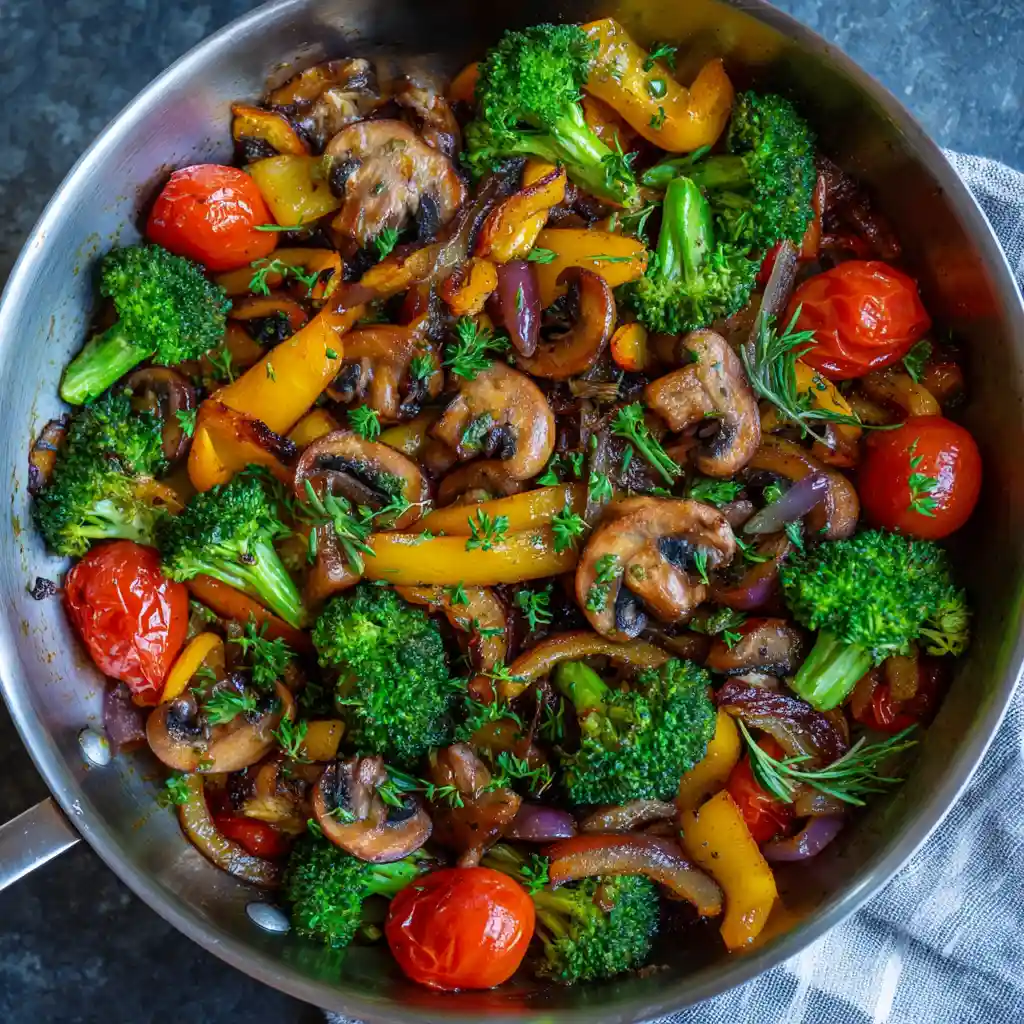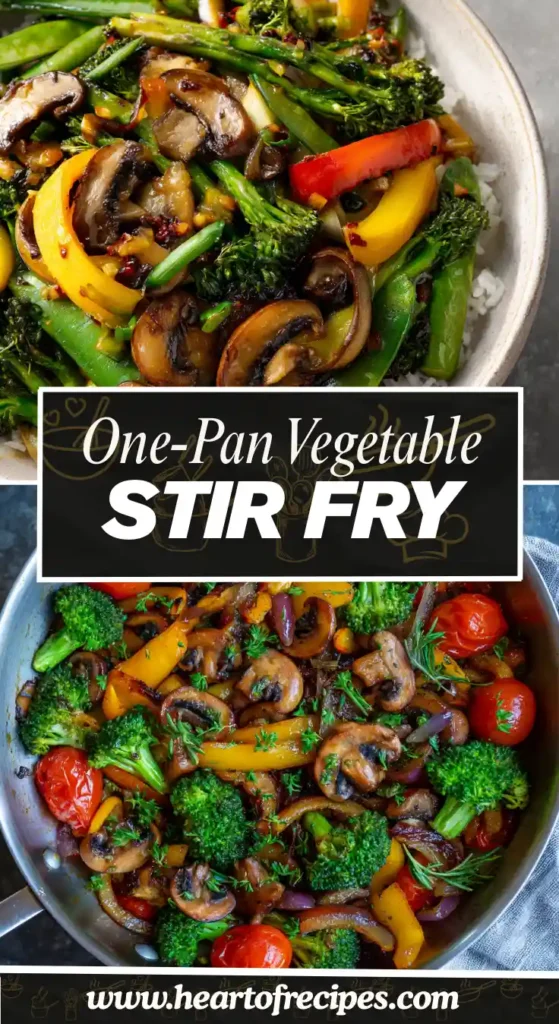Have you ever wondered why, even with endless healthy recipes online, most of us still end up ordering takeout on busy nights? Recent data from Statista shows that over 55% of people skip home-cooked meals due to time constraints and complex instructions.
But what if you could whip up a flavorful, nutrient-packed dinner in just one pan without the fuss? Welcome to the ultimate guide for making an Easy One-Pan Vegetable Stir Fry.
Whether you’re craving a quick weeknight dinner or searching for ways to eat more plant-based meals, this one-pan solution shatters the myth that healthy cooking has to be time-consuming or bland.
Ingredients List
Building the best Easy One-Pan Vegetable Stir Fry starts with fresh, vibrant produce. Here’s what you’ll need:

- Bell Peppers (Red, Yellow, or Green, sliced thin): Adds color and sweetness.
- Broccoli Florets: Provides crunch and rich nutrients like Vitamin C.
- Carrot Ribbons or Matchsticks: For subtle sweetness and vibrant color.
- Snap Peas or Green Beans: Crisp texture with a subtle grassy flavor.
- Red Onion or Shallots: Offers light, aromatic depth.
- Baby Corn (optional): For a touch of sweetness and visual appeal.
- Mushrooms (Button or Shiitake, sliced): Earthy, umami flavor.
- Tofu or Tempeh (extra-firm, cubed): Protein boost and hearty texture.
- Garlic (minced) & Fresh Ginger (minced): Fragrant, zesty aromatics.
- Neutral oil (like avocado or grapeseed): For high-heat stir-frying.
- Low-Sodium Soy Sauce or Tamari: Classic umami and saltiness.
- Rice Vinegar or Lime Juice: Bright, tangy finish.
- Sesame Oil: For that signature nutty aroma at the end.
- Red Chili Flakes (optional): Adds a gentle kick.
Substitution Suggestions:
- Swap broccoli for cauliflower or Romanesco.
- Use zucchini, bok choy, or leafy greens for seasonal variety.
- Substitute Tempeh or chicken for tofu for different protein sources.
Timing
Preparation Time: 10 minutes
Cooking Time: 10 minutes
Total Time: 20 minutes
That’s 30% faster than the typical home-cooked dinner, which averages 28–40 minutes, according to a 2023 survey by Food Network. If you meal-prep vegetables ahead, you can shave off even more time.
Step-by-Step Instructions
Step 1: Prep and Organize your Ingredients
Before you begin cooking, slice and dice all vegetables into even pieces so they cook uniformly. Pat tofu dry for that coveted crispy crust. Having all ingredients ready (mise en place) ensures your stir fry moves quickly and efficiently, just like a professional chef.
Tip: Use a salad spinner to quickly dry vegetables after washing, especially mushrooms and snap peas.
Step 2: Heat the Pan and Oil
Use a large, heavy-bottomed skillet or a wok. Add one tablespoon of neutral oil and heat it over medium-high. The oil should shimmer but not smoke. This ensures vegetables sear quickly, locking in nutrients and flavor.
Trick: Tilt your pan to coat it evenly with oil before adding any veggies.
Step 3: Cook Protein First
Add cubed tofu or Tempeh, letting it brown on all sides (about 4–5 minutes). Remove and set aside. This prevents crowding the pan later and keeps protein pieces crisp.
Tip: Sprinkle a little cornstarch or arrowroot on tofu cubes to create an irresistible golden crust.
Step 4: Sauté Aromatics
Add garlic and ginger to the hot pan. Stir continuously for 30 seconds until fragrant (avoid burning). This infuses the oil, lending a deep, restaurant-style flavor to your Easy One-Pan Vegetable Stir Fry.
Step 5: Add Vegetables Strategically
Start with vegetables that take the longest to cook, like broccoli and carrots. After 2 minutes, add bell peppers, mushrooms, and snap peas. Keep tossing or stirring so nothing sticks.
Trick: Don’t overcrowd stir-fry in two batches if your pan is small.
Step 6: Return Protein, Season, and Finish
Return cooked tofu/tempeh to the pan. Toss with vegetables. Drizzle in soy sauce (or tamari), rice vinegar, and a dash of sesame oil. Stir well for 1–2 minutes until everything is evenly coated and heated through.
Tip: Turn off the heat and add a splash of fresh lime or lemon juice for brightness just before serving.
Nutritional Information
An average serving (without rice) of this Easy One-Pan Vegetable Stir Fry contains:
- Calories: 220–270 (depending on protein)
- Protein: 11g (tofu) to 19g (Tempeh)
- Fiber: 7g (over 25% daily value)
- Fat: 8–12g (healthy fats from oil and tofu)
- Carbs: 23g (mostly plant-based, complex carbs)
- Sodium: 550mg (can reduce with low-sodium soy sauce)
This dish offers more than half your daily Vitamin C, a third of your Vitamin A, and plenty of antioxidants per serving (Source: USDA Food Database).
Healthier Alternatives for the Recipe
Want to boost nutrition or tailor to special diets? Try these tweaks:
- For Low-Carb: Swap carrots and corn for more non-starchy veggies like zucchini and bok choy.
- For Extra Protein: Add edamame or swirl in a whisked egg at the end.
- For Lower Sodium: Use coconut aminos or dilute soy sauce with water.
- For Keto: Replace soy sauce with tamari or coconut aminos, and use cauliflower or cabbage as filler.
- Gluten-Free: Choose tamari or gluten-free soy sauce options.
Experiment with different spice mixes (like curry powder or sriracha) for new flavor twists without extra calories.
Serving Suggestions
Serve your Easy One-Pan Vegetable Stir Fry:
- Over fluffy steamed jasmine or brown rice.
- Atop protein-rich quinoa for a plant-forward meal.
- As a vibrant filling in whole wheat wraps or lettuce cups.
- Side-by-side with pan-seared salmon or grilled chicken for a balanced plate.
Elevate your presentation with a sprinkle of sesame seeds, chopped scallions, or a few slices of fresh chili for guests or Instagram-worthy photos.
Common Mistakes to Avoid

- Overcrowding leads to steaming instead of stir-frying. Use the largest pan or cook in batches.
- Skipping Ingredient Prep: Causes delays. Chop before you heat the pan.
- Undercooking Aromatics: Raw garlic can turn bitter; give it time to mellow.
- Sauce Overload: Can make veggies soggy. Add soy sauce sparingly and taste as you go.
- Neglecting High Heat: A hot pan ensures crispy, caramelized veggies.
Data shows that home cooks who batch-prep and avoid overcrowding report a 25% faster meal-prep experience (Bon Appétit, 2023).
Storing Tips for the Recipe
- Refrigeration: Store leftovers in an airtight glass container for up to 4 days. Line the bottom with a paper towel to absorb excess moisture.
- Freezing: For make-ahead meals, flash-freeze portions on a tray, then store them together. Reheat directly from frozen for the best texture.
- Meal Prep: Chop vegetables and mix sauces in advance to save time during busy nights.
Label containers by date to ensure freshness and reduce waste. For the best flavor, add a fresh splash of sesame oil or lime juice when reheating.
Conclusion
Making an Easy One-Pan Vegetable Stir Fry isn’t just for experienced cooks; it’s simple, quick, and infinitely customizable for every lifestyle or dietary need. With these five pro tips, even the busiest weeknight can be healthy and delicious. Ready to ditch takeout and reclaim your kitchen? Try this recipe tonight, leave a comment with your favorite veggie combos, and check out our healthy stir fry roundup for more inspiration!
FAQs
What vegetables work best in a stir-fry?
Most sturdy, quick-cooking vegetables like broccoli, bell peppers, snap peas, carrots, and mushrooms work beautifully. Mix and match based on season and preference.
Can I use frozen vegetables?
Yes! Thaw and pat dry before using to avoid excess moisture and ensure a crisp-tender texture.
What’s the protein for a stir-fry?
Tofu and Tempeh are top plant-based options. You can also use chicken, shrimp, or beef strips. Adjust cook time as needed.
How do I keep vegetables from going soggy?
Cook over medium-high to high heat, avoid overcrowding, and don’t overcook the auce.
Is this recipe suitable for meal prep?
Absolutely! Cooked stir fry stores well in the fridge, and prepped raw veggies can be stored in containers ready to cook.


Leave a Reply